The desktop CNC milling machines market reaches USD 1,292.3 million in 2025 and is projected to grow to USD 1,894.6 million by 2035, with a CAGR of 3.9%. From 2021 to 2025, the market is expected to expand from USD 1,067.3 million to USD 1,292.3 million, with intermediate values of USD 1,108.9 million, USD 1,152.1 million, USD 1,197.1 million, and USD 1,243.8 million. This growth is driven by the increasing adoption of desktop CNC milling machines in education, prototyping, and small-scale manufacturing. Technological advancements, affordability improvements, and growing demand for compact, high-precision machines in small workshops fuel this early-stage expansion. The market benefits from a rise in DIY and hobbyist projects, along with demand for customization in manufacturing and product development.
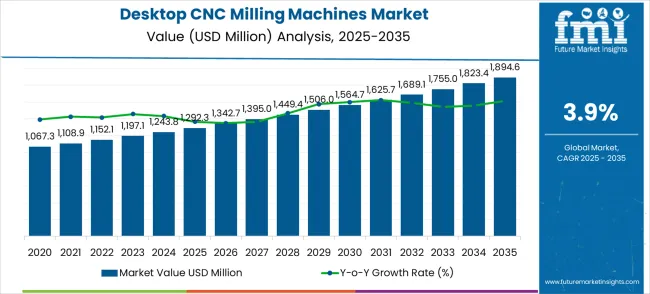
Between 2026 and 2030, the market strengthens further from USD 1,292.3 million to USD 1,506.0 million, with intermediate values of USD 1,342.7 million, 1,395.0 million, and 1,449.4 million. The growth during this period is supported by an increasing range of industries adopting desktop CNC milling machines for custom manufacturing and small-batch production, including sectors like aerospace, automotive, and consumer electronics. By 2030, the market reaches USD 1,564.7 million, continuing its steady climb. The final stretch from 2031 to 2035 sees the market reach USD 1,894.6 million, with intermediate increments through USD 1,625.7 million, USD 1,689.1 million, USD 1,755.0 million, and USD 1,823.4 million. This growth is driven by automation trends, increasing demand for rapid prototyping, and the expansion of industries leveraging desktop CNC machines for precision, low-volume production.
| Desktop CNC Milling Machines Market | Value |
|---|---|
| Market Value (2025) | USD 1,292.3 million |
| Market Forecast Value (2035) | USD 1,894.6 million |
| Market Forecast CAGR | 3.9% |
The industrial machinery market contributes about 30-35%, driven by the increasing demand for precise and compact milling machines in small-scale manufacturing, prototyping, and educational setups. Desktop CNC milling machines are crucial for industries that require high precision in small parts production without the need for large-scale machinery. The 3D printing and additive manufacturing market adds roughly 20-25%, as the growing trend toward integrated manufacturing processes often combines both additive and subtractive methods, leading to increased use of desktop CNC milling machines in rapid prototyping and custom production.
The electronics and semiconductor market contributes around 15-18%, with desktop CNC milling machines used for the precise machining of microelectronic components, circuit boards, and connectors. The hobbyist and DIY market accounts for approximately 10-12%, driven by the rising popularity of personal fabrication, DIY projects, and small-batch production where affordability and compactness are crucial. The education and training market contributes about 8-10%, as desktop CNC milling machines are widely used in vocational schools, universities, and training centers to provide hands-on learning experiences in manufacturing, machining, and robotics.
Market expansion is being supported by the rapid increase in educational technology adoption worldwide and the corresponding need for accessible precision manufacturing equipment that provides superior learning outcomes and operational flexibility. Modern educational institutions rely on hands-on learning experiences and practical skill development to ensure optimal student engagement including engineering programs, technical schools, and research facilities. Even minor equipment limitations can require comprehensive curriculum adjustments to maintain optimal educational standards and learning performance.
The growing complexity of engineering education requirements and increasing demand for practical manufacturing solutions are driving demand for desktop CNC equipment from certified manufacturers with appropriate educational capabilities and technical expertise. Educational institutions are increasingly requiring documented learning outcomes and equipment reliability to maintain educational quality and cost effectiveness. Industry specifications and educational standards are establishing standardized manufacturing curricula that require specialized equipment technologies and trained instructors.
The Desktop CNC Milling Machines market is entering a new phase of growth, driven by demand for accessible manufacturing, educational technology advancement, and evolving maker movement standards. By 2035, these pathways together can unlock USD 180-220 million in incremental revenue opportunities beyond baseline growth.
Pathway A -- Entry-Level Equipment Leadership (3-Axis Machines) The 3-axis segment already holds the largest share due to its balance of functionality and accessibility. Expanding educational partnerships, software integration, and starter bundles can consolidate leadership. Opportunity pool: USD 50-65 million.
Pathway B -- Educational Institution Applications (Schools & Universities) Education and training account for the majority of demand. Growing STEM education initiatives, especially in emerging economies, will drive higher adoption of desktop CNC machines for manufacturing education. Opportunity pool: USD 40-55 million.
Pathway C -- Maker Space & Community Workshop Growth Maker spaces and community workshops are expanding, especially in urban centers. Desktop CNC machines designed for shared-use environments (durable, user-friendly, multi-material capable) can capture significant growth. Opportunity pool: USD 25-35 million.
Pathway D -- Small Business & Entrepreneurship Small manufacturers and entrepreneurs present growing demand due to accessible manufacturing technology. Targeting business-focused features and production-ready capabilities will accelerate adoption. Opportunity pool: USD 20-30 million.
Pathway E -- Advanced Axis Configuration Growth 4-axis and 5-axis desktop machines offer enhanced capabilities for complex geometries. Educational institutions and advanced users seek more sophisticated machining options. Opportunity pool: USD 15-25 million.
Pathway F -- Software & Digital Integration Desktop CNC machines with cloud connectivity, remote monitoring, and advanced CAM software offer premium positioning for professional and educational applications. Opportunity pool: USD 12-18 million.
Pathway G -- Material Compatibility Expansion Machines capable of machining diverse materials including metals, composites, and advanced polymers create new market segments for specialized applications. Opportunity pool: USD 8-12 million.
Pathway H -- Service, Training & Support Ecosystem Comprehensive training programs, technical support, and educational curriculum development create recurring revenue streams and strengthen customer relationships. Opportunity pool: USD 5-8 million.
The market is segmented by product configuration, application, and region. By product configuration, the market is divided into 3-axis, 4-axis, 5-axis, and others. Based on application, the market is categorized into education and training, engineering research and development, and others. Regionally, the market is divided into North America, Europe, East Asia, South Asia & Pacific, Latin America, and Middle East & Africa.
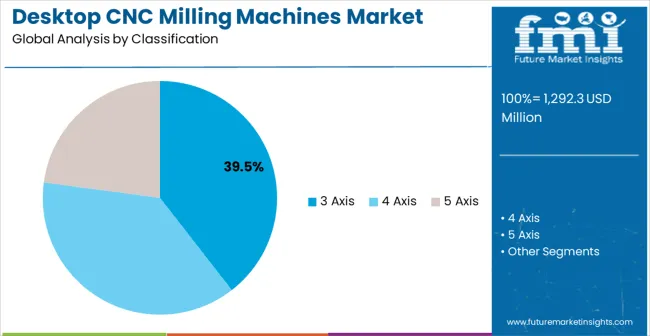
In 2025, the 3-axis desktop CNC milling machine segment is projected to capture the largest portion of the total market share of 39.5%, making it the leading product category. This dominance is largely driven by the widespread adoption of fundamental machining applications that require reliable three-dimensional cutting capabilities, catering to a wide variety of educational and prototyping applications. The 3-axis configuration is particularly favored for its ability to deliver effective machining performance across diverse materials with manageable complexity, ensuring operational accessibility. Educational institutions, research facilities, maker spaces, and small manufacturing operations increasingly prefer this configuration, as it meets precision machining needs without imposing excessive operational complexity or training requirements.
The availability of well-established product lines, along with comprehensive software support and aftersales service from leading manufacturers, further reinforces the segment's market position. This configuration category benefits from consistent demand across regions, as it is considered the optimal entry-level solution for precision machining applications of varying complexity. The combination of accessibility, performance, and versatility makes 3-axis desktop CNC machines a reliable choice, ensuring their continued popularity in the desktop manufacturing equipment market.
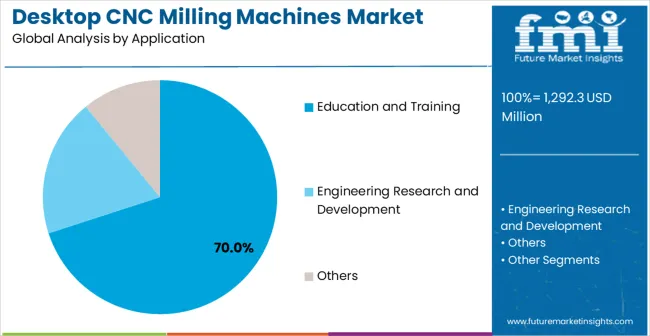
The education and training segment is expected to lead 70% market share represent the majority of desktop CNC milling machine demand in 2025, highlighting its position as the most significant application sector. This dominance stems from the unique operational needs of educational environments, where hands-on learning and skill development are critical to student success. Educational institutions often feature diverse curriculum requirements that demand flexible, user-friendly manufacturing equipment. Desktop CNC milling machines are particularly well-suited to these environments due to their ability to deliver precision machining capabilities safely and effectively, even with novice operators.
The expansion of educational institutions globally, coupled with a strong focus on improved practical learning standards, is driving the rising demand for desktop CNC machines. The segment also benefits from a heightened focus within the education industry, where institutions are increasingly prioritizing hands-on learning and technical skills as differentiators to attract and retain students. With educational institutions investing in modern manufacturing technology and practical learning, desktop CNC machines provide an essential solution to maintain high-performance education. The growth of STEM programs, coupled with increased focus on practical learning standards, ensures that education will remain the largest and most stable demand driver for desktop CNC milling machines in the forecast period.
The desktop CNC milling machines market is advancing steadily due to increasing educational technology adoption and growing recognition of desktop manufacturing advantages over traditional machining methods. The market faces challenges including higher complexity compared to manual operations, need for specialized training for effective operation, and varying technical requirements across different application environments. Performance optimization efforts and technology advancement programs continue to influence equipment development and market adoption patterns.
The growing development of advanced desktop CNC systems is enabling higher precision output with improved user accessibility and enhanced automation characteristics. Enhanced control technologies and optimized software systems provide superior machining performance while maintaining educational compliance requirements. These technologies are particularly valuable for educational institutions who require reliable equipment performance that can support diverse learning applications with consistent results.
Modern desktop CNC milling machine manufacturers are incorporating advanced user interface features and ergonomic design improvements that enhance operator efficiency and equipment effectiveness. Integration of advanced safety systems and optimized control interfaces enables superior learning outcomes and comprehensive skill development capabilities. Advanced equipment features support operation in diverse educational environments while meeting various safety requirements and operational specifications.
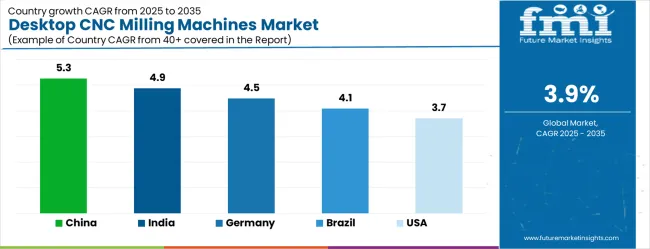
| Country | CAGR (2025-2035) |
|---|---|
| China | 5.3% |
| India | 4.9% |
| Germany | 4.5% |
| Brazil | 4.1% |
| United States | 3.7% |
| United Kingdom | 3.3% |
| Japan | 2.9% |
The desktop CNC milling machines market is growing rapidly, with China leading at a 5.3% CAGR through 2035, driven by strong educational infrastructure development and increasing adoption of manufacturing technology in academic institutions. India follows at 4.9%, supported by rising technical education development and growing demand for practical learning solutions. Germany grows steadily at 4.5%, integrating desktop CNC technology into its established educational and research infrastructure. Brazil records 4.1%, emphasizing educational modernization and technology upgrade initiatives. The United States shows solid growth at 3.7%, focusing on educational enhancement and operational efficiency. The United Kingdom demonstrates steady progress at 3.3%, maintaining established educational applications. Japan records 2.9% growth, concentrating on technology advancement and quality optimization.
The report covers an in-depth analysis of 40+ countries with top-performing countries highlighted below.
Revenue from desktop CNC milling machines in China is projected to exhibit the highest growth rate with a CAGR of 5.3% through 2035, driven by rapid expansion of technical education infrastructure and increasing demand for advanced manufacturing equipment in academic institutions. The country's growing focus on practical learning and expanding educational technology initiatives are creating significant demand for accessible CNC machining solutions. Major educational institutions are establishing comprehensive manufacturing laboratories to support the increasing requirements of engineering education and technical skill development across metropolitan markets. Government educational development programs are supporting establishment of modern technical facilities and educational complexes, driving demand for advanced desktop CNC systems throughout major educational zones.
The desktop CNC milling machine market in India is expanding at a CAGR of 4.9%, supported by increasing technical education sector development and growing awareness of hands-on learning infrastructure benefits. The country's expanding engineering education and rising practical learning standards are driving demand for advanced desktop manufacturing solutions. Educational institutions and technical colleges are gradually implementing desktop CNC systems to maintain educational standards and operational efficiency. Technical education sector growth and skill development infrastructure are creating opportunities for equipment suppliers that can support diverse educational requirements and operational specifications.
Demand for desktop CNC milling machines in Germany is projected to grow at a CAGR of 4.5%, supported by the country's focus on educational technology quality standards and advanced manufacturing education adoption. German educational institutions are implementing comprehensive desktop CNC systems that meet stringent performance requirements and operational specifications. The market is characterized by focus on system reliability, educational efficiency, and compliance with comprehensive technical education standards. Educational industry investments are prioritizing advanced CNC technology that demonstrates superior performance and reliability while meeting German quality and educational standards.
Revenue from desktop CNC milling machines in Brazil is growing at a CAGR of 4.1%, driven by increasing educational infrastructure development and growing recognition of desktop manufacturing system advantages. The country's expanding technical education sector is gradually integrating desktop CNC infrastructure to enhance practical learning and operational efficiency. Educational facilities and technical institutions are investing in CNC technology to address evolving educational requirements and learning standards. Educational modernization initiatives are facilitating adoption of advanced manufacturing technologies that support comprehensive practical learning capabilities across educational regions.
The sale of desktop CNC milling machines in the USA is expanding at a CAGR of 3.7%, driven by established educational industries and growing focus on practical learning infrastructure enhancement. Large educational institutions and technical colleges are implementing comprehensive desktop CNC capabilities to serve diverse educational requirements. The market benefits from established equipment distribution networks and professional training programs that support various educational applications. Educational industry leadership is enabling standardized equipment utilization across multiple institution types, providing consistent learning quality and comprehensive educational coverage throughout regional markets.
Demand for desktop CNC milling machines in the UK is projected to grow at a CAGR of 3.3%, supported by established educational sectors and growing focus on practical learning capabilities. British educational institutions and technical colleges are implementing desktop CNC systems that meet industry quality standards and operational requirements. The market benefits from established educational infrastructure and comprehensive training programs for educational professionals. Educational infrastructure investments are prioritizing advanced manufacturing equipment that supports diverse learning applications while maintaining established quality and operational standards.
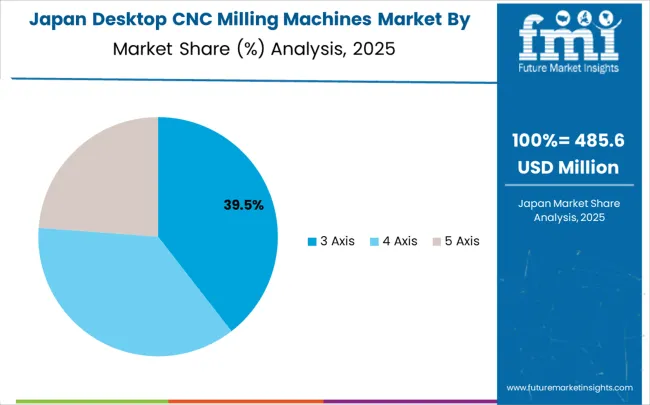
The desktop CNC milling machine market in Japan is growing at a CAGR of 2.9%, driven by the country's focus on manufacturing technology innovation and quality enhancement applications. Japanese educational institutions are implementing advanced desktop CNC systems that demonstrate superior performance reliability and operational efficiency. The market is characterized by focus on technological excellence, quality assurance, and integration with established educational infrastructure workflows. Technology industry investments are prioritizing innovative CNC solutions that combine advanced manufacturing technology with precision engineering while maintaining Japanese quality and reliability standards.
The desktop CNC milling machines market in Europe is forecast to expand from USD 285.4 million in 2025 to USD 418.2 million by 2035, registering a CAGR of 3.8%. Germany will remain the largest market, holding 28.5% share in 2025, easing to 28.0% by 2035, supported by strong engineering education infrastructure and advanced technical training programs. The United Kingdom follows, rising from 22.0% in 2025 to 22.5% by 2035, driven by maker spaces and educational technology adoption. France is expected to decline slightly from 18.0% to 17.5%, reflecting market maturation pressures. Italy maintains stability at around 15.0%, supported by technical education and small manufacturing growth, while Spain grows from 8.5% to 9.0% with expanding technical education and maker movement demand. BENELUX markets ease from 5.0% to 4.8%, while the remainder of Europe hovers near 3.0%-3.2%, balancing emerging Eastern European growth against mature Nordic markets.
The Desktop CNC Milling Machines market is defined by competition among specialized equipment manufacturers, educational technology companies, and manufacturing solution providers. Companies are investing in advanced CNC technology development, equipment performance optimization, user-friendly design improvements, and comprehensive educational support capabilities to deliver reliable, efficient, and cost-effective desktop manufacturing solutions. Strategic partnerships, technological innovation, and market expansion are central to strengthening product portfolios and market presence.
Carbide 3D offers comprehensive desktop CNC solutions with established manufacturing expertise and educational-focused equipment capabilities. SainSmart provides specialized manufacturing equipment with focus on accessibility and operational efficiency. PROXXON delivers precision machining solutions with focus on quality and user-friendly operation. Penta Machine specializes in desktop CNC equipment with advanced manufacturing technology integration.
Datron AG offers professional-grade CNC systems with comprehensive technical support capabilities. JET Tools delivers established manufacturing solutions with advanced desktop CNC technologies. Tormach provides specialized machining equipment with focus on performance optimization. Onefinity, BobsCNC, OpenBuilds, Roland DG, Bantam Tools, and Makera offer specialized manufacturing expertise, equipment reliability, and comprehensive product development across global and regional market segments.
| Item | Value |
|---|---|
| Quantitative Units | USD 1,292.3 million |
| Product Configuration | 3-Axis, 4-Axis, 5-Axis |
| Application | Education and Training, Engineering Research and Development, Others |
| Regions Covered | North America, Europe, East Asia, South Asia & Pacific, Latin America, Middle East & Africa |
| Country Covered | China, India, Germany, Brazil, United States, United Kingdom, Japan, and 40+ countries |
| Key Companies Profiled | Carbide 3D, SainSmart, PROXXON, Penta Machine, Datron AG, JET Tools, Tormach, Onefinity, BobsCNC, OpenBuilds, Roland DG, Bantam Tools, Makera |
| Additional Attributes | Dollar sales by product configuration and application segment, regional demand trends across major markets, competitive landscape with established equipment manufacturers and emerging technology providers, customer preferences for different machine specifications and software options, integration with educational curriculum systems and manufacturing protocols, innovations in desktop CNC technology and automation system enhancements, and adoption of user-friendly design features with enhanced precision capabilities for improved educational workflows. |
The global desktop CNC milling machines market is estimated to be valued at USD 1,292.3 million in 2025.
The market size for the desktop CNC milling machines market is projected to reach USD 1,894.6 million by 2035.
The desktop CNC milling machines market is expected to grow at a 3.9% CAGR between 2025 and 2035.
The key product types in desktop CNC milling machines market are 3 axis, 4 axis and 5 axis.
In terms of application, education and training segment to command 70.0% share in the desktop CNC milling machines market in 2025.






Our Research Products

The "Full Research Suite" delivers actionable market intel, deep dives on markets or technologies, so clients act faster, cut risk, and unlock growth.

The Leaderboard benchmarks and ranks top vendors, classifying them as Established Leaders, Leading Challengers, or Disruptors & Challengers.

Locates where complements amplify value and substitutes erode it, forecasting net impact by horizon

We deliver granular, decision-grade intel: market sizing, 5-year forecasts, pricing, adoption, usage, revenue, and operational KPIs—plus competitor tracking, regulation, and value chains—across 60 countries broadly.

Spot the shifts before they hit your P&L. We track inflection points, adoption curves, pricing moves, and ecosystem plays to show where demand is heading, why it is changing, and what to do next across high-growth markets and disruptive tech

Real-time reads of user behavior. We track shifting priorities, perceptions of today’s and next-gen services, and provider experience, then pace how fast tech moves from trial to adoption, blending buyer, consumer, and channel inputs with social signals (#WhySwitch, #UX).

Partner with our analyst team to build a custom report designed around your business priorities. From analysing market trends to assessing competitors or crafting bespoke datasets, we tailor insights to your needs.
Supplier Intelligence
Discovery & Profiling
Capacity & Footprint
Performance & Risk
Compliance & Governance
Commercial Readiness
Who Supplies Whom
Scorecards & Shortlists
Playbooks & Docs
Category Intelligence
Definition & Scope
Demand & Use Cases
Cost Drivers
Market Structure
Supply Chain Map
Trade & Policy
Operating Norms
Deliverables
Buyer Intelligence
Account Basics
Spend & Scope
Procurement Model
Vendor Requirements
Terms & Policies
Entry Strategy
Pain Points & Triggers
Outputs
Pricing Analysis
Benchmarks
Trends
Should-Cost
Indexation
Landed Cost
Commercial Terms
Deliverables
Brand Analysis
Positioning & Value Prop
Share & Presence
Customer Evidence
Go-to-Market
Digital & Reputation
Compliance & Trust
KPIs & Gaps
Outputs
Full Research Suite comprises of:
Market outlook & trends analysis
Interviews & case studies
Strategic recommendations
Vendor profiles & capabilities analysis
5-year forecasts
8 regions and 60+ country-level data splits
Market segment data splits
12 months of continuous data updates
DELIVERED AS:
PDF EXCEL ONLINE
Tabletop CNC Milling Machines Market Analysis - Size, Share, and Forecast Outlook 2025 to 2035
CNC Plasma Cutting Machines Market Size and Share Forecast Outlook 2025 to 2035
CNC Slitting Lathes Market Size and Share Forecast Outlook 2025 to 2035
CNC Abovefloor Wheel Lathe Market Size and Share Forecast Outlook 2025 to 2035
CNC Industrial Paper Cutter Market Size and Share Forecast Outlook 2025 to 2035
Desktop as a Service (DaaS) Market Size and Share Forecast Outlook 2025 to 2035
CNC Controller Market Size and Share Forecast Outlook 2025 to 2035
Milling Machine Market Growth – Trends & Forecast 2025 to 2035
Desktop Outsourcing Market
CNC Tool Storage System Market
End Milling Machine Market Report - Demand, Growth & Industry Outlook 2025 to 2035
Road Milling Machine Market Analysis and Opportunity Assessment in India Size and Share Forecast Outlook 2025 to 2035
Rice Milling Machine Market Size and Share Forecast Outlook 2025 to 2035
Tree Milling Machine Market Size and Share Forecast Outlook 2025 to 2035
Corn Milling Machine Market Size and Share Forecast Outlook 2025 to 2035
Maize Milling Machine Market Size and Share Forecast Outlook 2025 to 2035
Wheat Milling Machine Market Size and Share Forecast Outlook 2025 to 2035
Lathe Machines Market
Remote Desktop Software Market Forecast and Outlook 2025 to 2035
Sorter Machines Market Size and Share Forecast Outlook 2025 to 2035

Thank you!
You will receive an email from our Business Development Manager. Please be sure to check your SPAM/JUNK folder too.
Chat With
MaRIA